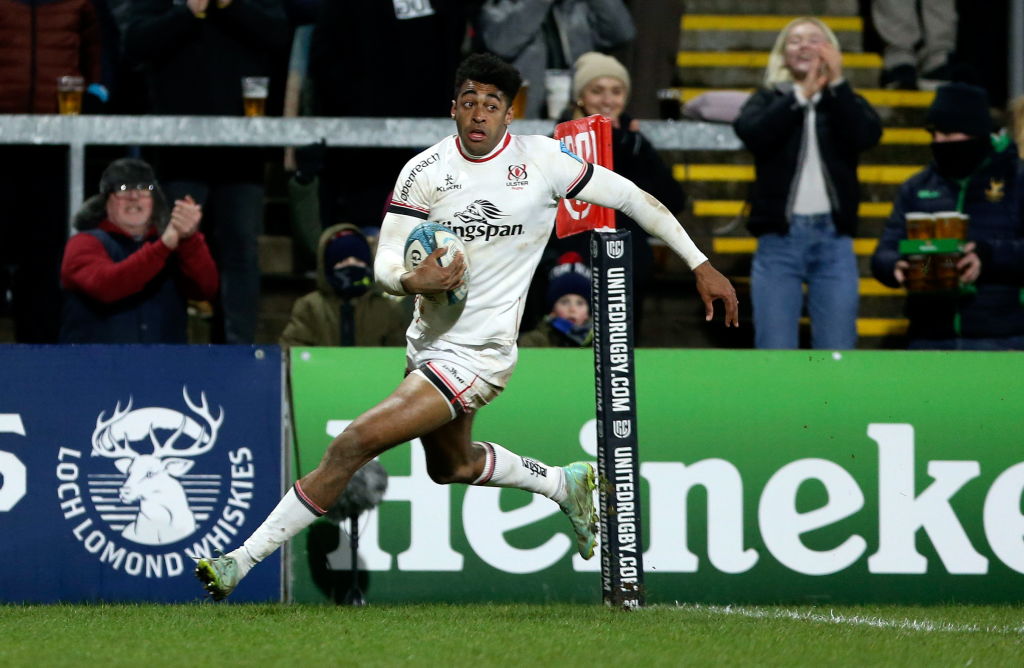In the latest of this series, Sam Larner breaks down a Jack Bates score with assistant coach Conor McPhillips
The Intercept: Bristol Bears Try Against Bath
Running rugby is a beautiful thing to witness. One team that can be relied upon to deliver it are Bristol Bears.
In the latest of our The Intercept series, we look at their fantastic long-range effort against Bath in the Premiership Rugby Cup, finished by Jack Bates.
We spoke with Bristol’s assistant coach Conor McPhillips to understand how this Bristol Bears try against Bath came together on and off the pitch.
ᴄᴏᴀꜱᴛ ᴛᴏ ᴄᴏᴀꜱᴛ ?️@jack_bateszzz with a ??? ?? ??? ?????? contender ? pic.twitter.com/O0QfgaXqmi
— Bristol Bears ? (@BristolBears) March 19, 2022
Two pass or not two pass?
We hear it at all levels, off a turnover you should move the ball two passes away from the turnover location. The idea is simple, the opposition should be strongest immediately around the turnover and so the further you move the weaker they will be. The problem is that you might just be ignoring the wide-open space immediately in front of you.
As McPhillips explains: “Often on a set-piece steal or transition, the space is out wide because the backs will be rushing into the backfield to prevent the 50:22 or the chip through. We wouldn’t want to throw big miss-passes, because ball in the air gives the defence time to adjust. If we go through the hands then we can fix the defence and preserve that space out wide.”
MORE FROM THE INTERCEPT SERIES
The Intercept: Ulster Try Against Connacht
Sam Larner breaks down Robert Baloucoune’s try in…
The Intercept: Loughborough Try Against Saracens
Sam Larner talks to Helena Rowland about her…
The Intercept: Racing 92 try against Stade Francais
In the first of a new series, Sam…
That is the goal and the logic. But of course, the defence also knows that they are weakest out wide and so perhaps in their rush to get wide they open up the middle. This is the game of chess that is modern rugby.
“There was space wide for this try and Bath tried to close that space. Teams will try and do that. The pleasing thing for us was that DT (Dan Thomas) moved the ball to Tiff (Tiff Eden) early. Tiff wanted to go wide but it was shut down, so he attacked the inside and a soft shoulder. That’s only good if he has support inside and out, and DT wanted to get that second touch and was there for the offload.”
Playing like Bristol doesn’t just happen organically. Sometimes the most off-the-cuff looking play actually takes the longest to perfect. “We train to keep the ball alive,” says McPhillips. “You obviously need a strong ruck but ideally we want to keep the ball in the air. In this offload, Tiff trusts the call on his inside and DT hits the ball at pace.
“Then you are in behind the defence. You have six or seven players in the lineout, the rest in the defensive line, and maybe only two or three in the backfield, so you are in behind 12 of the defenders. The important thing after a line break is not to run away from the ball-carrier. We want people going with the ball-carrier, so they are there for the offload or to clear out the ruck.”
"It was a real team performance" ?
Pat Lam on ??? #PremRugbyCup victory in BS3 ?️@CamworthLtd | #BristolBears pic.twitter.com/yEGXtqZE69
— Bristol Bears ? (@BristolBears) March 18, 2022
Something that fans dislike is the idea that players are becoming robotic and cannot think for themselves. The two pass ‘rule’ is one that might blunt an attacker’s ability. For McPhillips it is more complicated than that: “We want players to be looking upfield. If you are looking out wide and trying to get those two passes in, then you might be missing a hole to attack. We want our players with their hips square and identifying the space to attack.”
Process or Outcome
I know that phrases like ‘we trust the process’ really rile fans up. But a process is a vital thing. Imagine you coach a team and you have no process and just focus on the outcome. You only care about the outcome and so you have a fly-half who throws great looping miss-passes, which are successful 50% of the time. As a coach you would scold the fly-half 50% of the time and praise him the other 50% of the time. You can imagine how that would lead to confusion.
For McPhillips, improving his players and getting them into good habits is crucial. “We show our players what good looks like. So we show them that when they run laterally and throw big looping passes, then the defence adjust. But when they run with their hips upfield, then we see positive results.”
For McPhillips, the Jack Bates try was a near perfect example of everything that the players are trained to do. But that is because of the process that went into it; the good decision-making, hitting the offload at pace, turning hips upfield and then running towards the ball-carrier to provide support. If the process isn’t right, then regardless of the outcome there will be things to work on.
“If we threw a long pass and the opposition missed it by a fingertip and we scored the try but actually it was on to go hands, then that is the type of things we would pull the players up on. You don’t just say that because you scored a try then that’s great. You have to be true to your process.”
In the same game there was an example where an immediate try was prevented by excellent defensive work by Bath’s Gabriel Hamer-Webb. “Rich Lane got an interception from a defensive set and Hamer-Webb caught him literally a metre from the try-line. But then Niyi Adeolokun was there on his shoulder to get the pop. Niyi could have waited on the halfway line and cheered Rich on but he knew he had to get there in support and if he wasn’t there he wouldn’t have scored.
“And the same for Hamer-Webb, it was great from him to chase back and you have to credit him for saving that try. But then you could see from his reaction that he was upset that nobody else had tracked back.”
☁️ ????? 9⃣
A try-fest at the Gate under the ?????? ????? ?????? ?
Who enjoyed that one❓ pic.twitter.com/8xEC5BDWq6
— Bristol Bears ? (@BristolBears) March 19, 2022
And that is the process simply explained, regardless of whether Lane was caught, the work-rate of Adeolokun should always be praised.
Conclusion
Obviously, if you coach at a lower level you will have neither the time with the players that McPhillips has nor the class of player. However, you can still take something away from this article.
For me, the primary takeaway is all about process. If you are a coach or player who encourages your team to take risks and express themselves, while at the same time being critical when an offload doesn’t come off, then you are probably doing more harm than good.
As tough as it might be, you will probably find that your team gets better, not worse, when you let them play without fear of making a mistake.
Download the digital edition of Rugby World straight to your tablet or subscribe to the print edition to get the magazine delivered to your door.
Follow Rugby World on Facebook, Instagram and Twitter.








